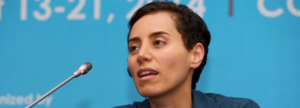 Iranian mathematics Professor Maryam Mirzakhani, the first and to-date only female winner of the Fields Medal since its inception in 1936, died Friday, July 14. Her receipt of the Fields Medal three years ago ended a long wait for women in the mathematics community for the prize, first established in 1936. Mirzakhani specialized in theoretical mathematics: moduli spaces, Teichmüller theory, hyperbolic geometry, Ergodic theory and symplectic geometry. The 2014 IMU press release about her work and for for winning in 2014 a Fields Medal can be found here.
Iranian mathematics Professor Maryam Mirzakhani, the first and to-date only female winner of the Fields Medal since its inception in 1936, died Friday, July 14. Her receipt of the Fields Medal three years ago ended a long wait for women in the mathematics community for the prize, first established in 1936. Mirzakhani specialized in theoretical mathematics: moduli spaces, Teichmüller theory, hyperbolic geometry, Ergodic theory and symplectic geometry. The 2014 IMU press release about her work and for for winning in 2014 a Fields Medal can be found here.
Mirzakhani was born in Tehran, Iran, and – by her own estimation – was fortunate to come of age after the Iran-Iraq war when the political, social and economic environment had stabilized enough that she could focus on her studies. She dreamed of becoming a writer, but mathematics eventually swept her away. She attended an all-girls high school in Tehran, led by a principal unbowed by the fact that no girl had ever competed for Iran’s International Mathematical Olympiad team. Mirzakhani first gained international recognition during the 1994 and 1995 competitions. In 1994, she earned a gold medal. In 1995, she notched a perfect score and another gold medal. After graduating college at Sharif University in Tehran, she headed to graduate school at Harvard University, where she was guided by Curtis McMullen, a fellow Fields Medal winner.
McMullen described Mirzakhani as filled with “fearless ambition.” Her 2004 dissertation was a masterpiece. In it, she solved two longstanding problems. Either solution would have been newsworthy in its own right, according to Benson Farb, a mathematician at the University of Chicago, but then Mirzakhani connected the two into a thesis described as “truly spectacular.” It yielded papers in each of the top three mathematics journals.“The majority of mathematicians will never produce something as good,” Farb said at the time. “And that’s what she did in her thesis.”
Iranian President Hassan Rouhani said the “unprecedented brilliance of this creative scientist and modest human being, who made Iran’s name resonate in the world’s scientific forums, was a turning point in showing the great will of Iranian women and young people on the path towards reaching the peaks of glory … in various international arenas,” according to Iranian state media.
“What’s so special about Maryam, the thing that really separates her, is the originality in how she puts together these disparate pieces,” said Steven Kerckhoff at the time of her Fields Medal award. Kerckhoff is a professor at Stanford who works in the same area of mathematics. “That was the case starting with her thesis work, which generated several papers in all the top journals. The novelty of her approach made it a real tour de force.”After earning her doctorate at Harvard, Mirzakhani accepted a position as assistant professor at Princeton University and as a research fellow at the Clay Mathematics Institute before joining the Stanford faculty.
“Maryam was a wonderful colleague,” said Ralph L. Cohen, the Barbara Kimball Browning Professor of Mathematics at Stanford. “She not only was a brilliant and fearless researcher, but she was also a great teacher and terrific PhD adviser. Maryam embodied what being a mathematician or scientist is all about: the attempt to solve a problem that hadn’t been solved before, or to understand something that hadn’t been understood before. This is driven by a deep intellectual curiosity, and there is great joy and satisfaction with every bit of success. Maryam had one of the great intellects of our time, and she was a wonderful person. She will be tremendously missed.” In recent years, she collaborated with Alex Eskin at the University of Chicago to answer a mathematical challenge that physicists have struggled with for a century: the trajectory of a billiard ball around a polygonal table. That investigation into this seemingly simple action led to a 200-page paper which, when it was published in 2013, was hailed as “the beginning of a new era” in mathematics and “a titanic work.”
“You’re torturing yourself along the way,” she would offer, “but life isn’t supposed to be easy.”
Deep condolences to the family, friends and colleagues of Maryam. A great loss.
Some short clips can be found here:
Video shown at the Fields Medalist Ceremony in 2014
Maryam Mirzakhani on "Dynamics on the Moduli Spaces of Curves", I
(Text above: summary from several sources, see here and here)
 Iranian mathematics Professor Maryam Mirzakhani, the first and to-date only female winner of the Fields Medal since its inception in 1936, died Friday, July 14. Her receipt of the Fields Medal three years ago ended a long wait for women in the mathematics community for the prize, first established in 1936. Mirzakhani specialized in theoretical mathematics: moduli spaces, Teichmüller theory, hyperbolic geometry, Ergodic theory and symplectic geometry. The 2014 IMU press release about her work and for for winning in 2014 a Fields Medal can be found
Iranian mathematics Professor Maryam Mirzakhani, the first and to-date only female winner of the Fields Medal since its inception in 1936, died Friday, July 14. Her receipt of the Fields Medal three years ago ended a long wait for women in the mathematics community for the prize, first established in 1936. Mirzakhani specialized in theoretical mathematics: moduli spaces, Teichmüller theory, hyperbolic geometry, Ergodic theory and symplectic geometry. The 2014 IMU press release about her work and for for winning in 2014 a Fields Medal can be found